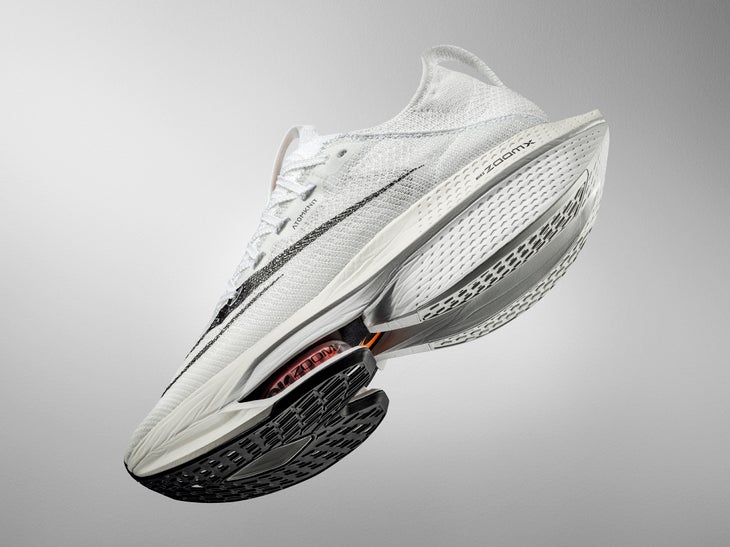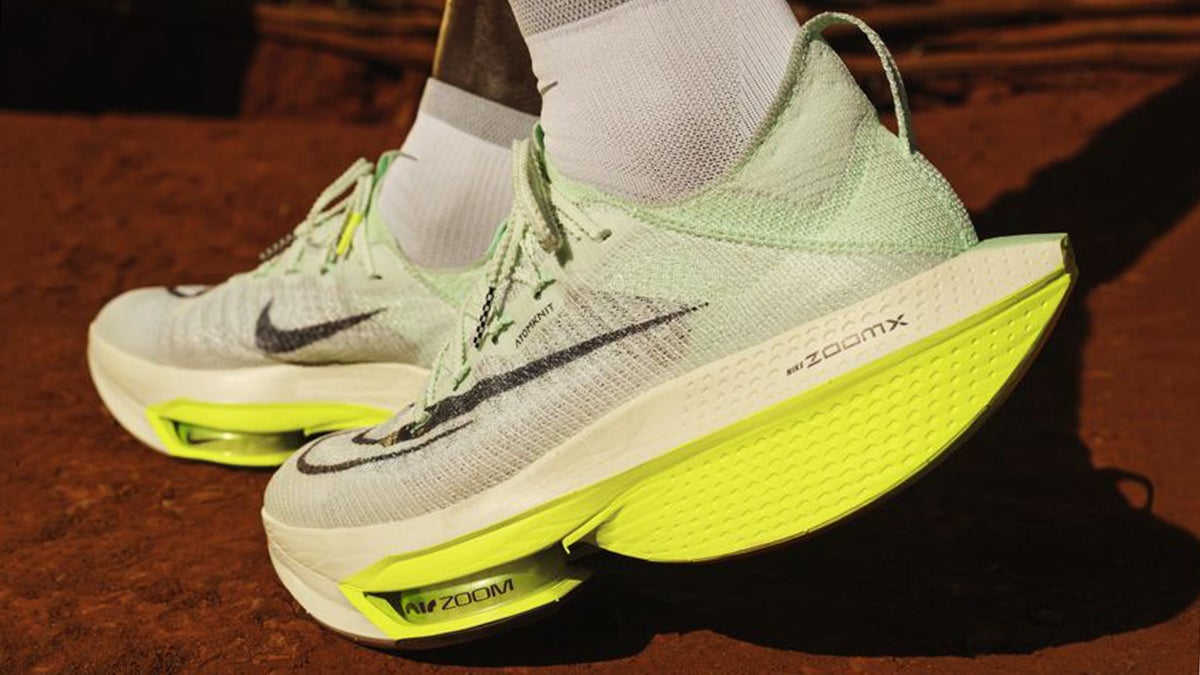No products in the cart.
Outdoor Adventure
Nike’s AlphaFly Next% Just Got Redesigned
Look at the feet of runners on any marathon starting line worldwide and you’ll find the Nike Air Zoom Alphafly Next% on most of them. It shouldn’t be surprising; after all, this was the shoe Eliud Kipchoge wore when he clocked a 1:59 marathon in 2019. What runner wouldn’t want to wear the identical kicks that contributed to the fastest marathon ever?
As you look toward the back corrals, however, the Alphaflys start to disappear. It isn’t that these runners aren’t serious enough to shell out $275; it’s because the Alphafly Next% was designed solely with the elite runner in mind. The shoe’s aggressive, forefoot-favoring geometry and soft, unstable midsole benefits efficient runners and leaves most wobbling behind.
That’s about to change. The world’s fastest marathon shoe has received a complete top-to-bottom update to create a shoe that will accommodate more of the masses, not just elites like Kipchoge. I was one of the few granted early access to the new Nike Air Zoom Alphafly Next% 2, and after spending a few weeks testing the new supershoe, I can confirm that the brand hit its mark.
Nike Air Zoom Alphafly Next% 2 Specs
MSRP: $275
Weight: Men’s, 8.8 ounces; women’s, 7 ounces
Offset: 8 millimeters
What’s New
- Three additional millimeters in heel width and two more millimeters in forefoot width, to improve stability
- A heel drop that has increased from four to eight millimeters, to accommodate more mid- and rear-foot strikers
- A contoured insole and additional midsole width under the arch for better support
- A new, lighter outsole for enhanced traction and durability
- The addition of a thin layer of ZoomX midsole under forefoot Zoom Air pods, for smoother transitions
- A revamped upper, which provides a more secure lockdown, increased breathability, and improved overall comfort
- A softer heel counter to relieve pressure along the Achilles tendon
- Extra padding in the tongue to improve comfort when laces are cinched tight
What’s the Same
- Nike’s lightest and most resilient ZoomX foam, for superior cushioning and energy return
- A full-length curved carbon-fiber plate, to add rigidity and assist with toe-offs
- Dual forefoot Zoom Air pods that combine pressurized air and tightly stretched fibers, for added cushioning and rebound

The Lowdown
I’ve been reviewing products for Outside since 2018, and it takes a lot to get me genuinely excited about a pair of shoes, especially updates to existing models. After hearing about the improvements to the Alphafly Next% 2, however, I was eager to test it out and see if the hype was true.
One of the biggest complaints I’ve heard from non-elite runners about the original Alphafly Next% was a feeling of sinking back into the heel, which reduced the rolling, forward energy of the shoe. That, combined with its supersoft midsole, created a wobbly, unstable feeling, especially for rear-foot and some midfoot strikers.
As soon as I stepped into the Alphafly Next% 2, I could tell it was more grounded and stable. I didn’t notice the same sinking feeling as the original, thanks to two sizable updates. First, the heel drop doubled from four millimeters to eight. Second, the midsole geometry was altered, creating a wider base beneath the heel and midfoot and wrapping further up the sides, cupping the foot.
Elliott Heath, footwear product manager at Nike Running, said the reasoning behind the higher heel drop height was to allow runners of different foot strikes and strides to feel a bit more comfortable. Heath maintained that faster runners will also benefit, because as they start to tire during later stages of a marathon, they undoubtedly begin to shift toward more of a rear strike. At that point, the higher heel will better support the foot and and roll it forward. As someone who lands midfoot to forefoot, the additional drop was noticeable, but not in an obtrusive way. With the original, if I wasn’t running up on my forefoot, it felt like I was forced into the back seat of the shoe. The new model felt more fluid across all paces.
One of the more subtle updates, but a game changer for me, was the wider midfoot. On the original Alphafly, I had serious issues with the extremely narrow midsection, which left the arch unsupported. The midsole under the Alphafly Next% 2 arch is cut away less and features a slight upward contour for support. While the new iteration is a little more than half an ounce heavier per pair, the result is a significantly stabler feel that persisted as I took the shoe through various paces.
Whatever speed I ran, the Alphafly Next% 2 fell into a smooth, rhythmic cadence, as if it knew what pace I wanted, and locked in on it. The original, in contrast, felt disjointed as I transitioned from the soft ZoomX heel onto the firmer outsole underneath the forefoot Zoom Air pods.
Heath explained that the key to this smoother transition is a new, thinner, lighter, and more durable outsole material. By using a thinner rubber, Heath and his team could add a four-millimeter layer of ZoomX underneath the Air pods, fixing that disjointed feeling I had experienced. As a bonus, the new outsole also seems to grip the road better.
To get a better feel for the differences between the old and new versions, I did some runs wearing the original Alphafly Next% on my right foot and the new Alphafly Next% 2 on my left. The contrast between the two was striking. The new version offered much smoother riding, especially at slower speeds. It delivered the same highly cushioned feeling, but as I transitioned from heel to toe, the new shoe displayed a cohesive flow that the original lacked. I also found the new version’s upper and insole made for a more comfortable, better-fitting shoe.
It’s worth mentioning that, while many of the stability issues have been resolved with the updates, this shoe still has a very high stack height. Its cornering ability has slightly improved, but personally, for races up to half marathon in length, I’d want a leaner, more nimble racing model.
As a coach, I’ve tended to shy away from suggesting the Alphafly to runners whose marathon times are slower than their Boston qualifying standard. After testing the Alphafly Next% 2, that’s going to change. While I doubt such runners will see the same efficiency gains as elite racers, I believe the new version will better accommodate their stride and the shoe’s maximal cushioning will reduce leg pounding.
I asked Heath what Kipchoge thought of the Alphafly Next% 2, which he wore at the Toyko Marathon in March. “This is the path forward,” was Kipchoge’s succinct reply. A pretty strong endorsement from arguably the greatest distance runner of all time. After testing the new shoe, I echo Kipchoge’s statement, with an addendum: this is the path forward, not only for elites but for all of us who want to maximize our marathon performances.
Did Nike make the Alphafly better? Yes, unequivocally—especially for the 99.99 percent of runners who aren’t Eliud Kipchoge.
Source link

